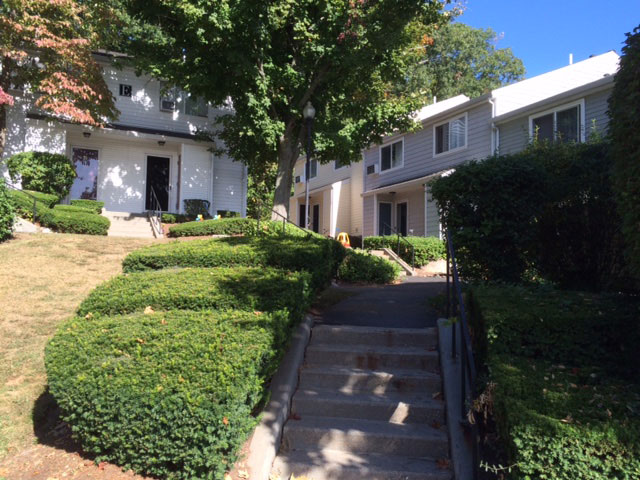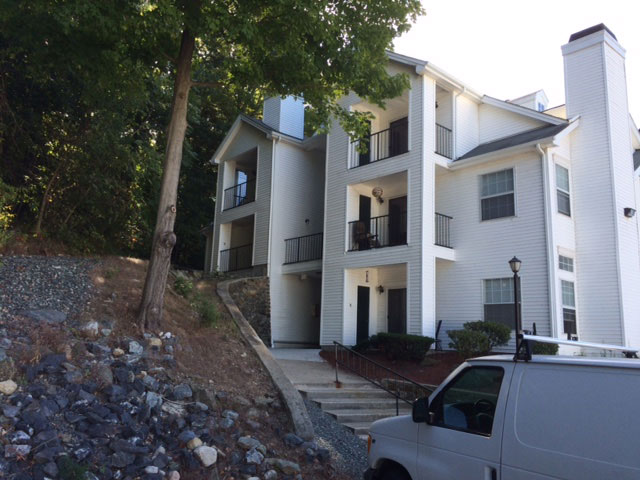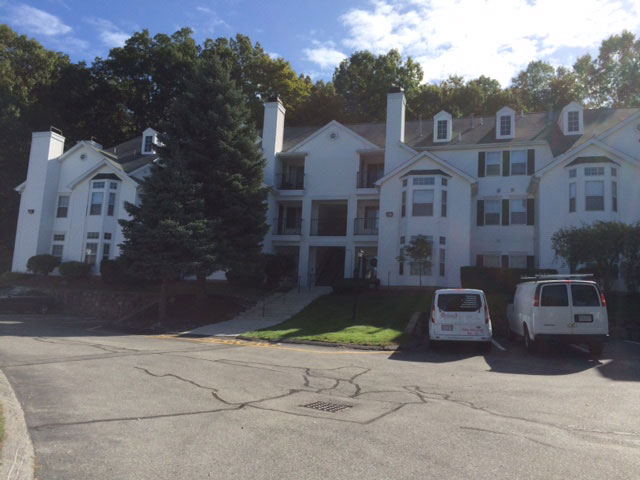
Article and photos by David DeStefano
The fire service has a loose definition of occupancies known as garden apartments. Found in communities of all size across the country, these buildings are multi-dwellings that vary in height up to approximately six floors. They may have exterior access for each unit or feature common interior corridors. Many are constructed with lightweight wood components and often are not sprinklered or equipped with standpipes. As the name implies, access may be limited by a courtyard or landscape features. As firefighters, we may be confronted with the significant challenges of rapid fire spread, early collapse, and numerous endangered occupants on arrival. In the following sections, we will explore some of the challenges companies may face during fires at these occupancies.
Access Limitations
In suburban settings, these occupancies are often designed in a manner that will complement the natural surroundings of the environment. This may present substantial grade differences between sides of the structure, narrow access points, or long setbacks from a road. Fire companies whose districts contain garden apartments should become familiar with access points for apparatus as well as areas inaccessible to aerial devices. Formulate a plan to quickly raise an adequate number of ground ladders to address rescue and firefighter safety, and to effect vertical or outside horizontal ventilation.
RELATED TRAINING: Garden Apartment and Townhouse Fires | THE CHALLENGE OF GARDEN APARTMENT FIRES: A REPORT | FIREGROUND SIZE-UP FOR GARDEN APARTMENTS AND TOWNHOUSES
Engine company firefighters must be prepared for stretches that may go beyond the reach of the average preconnect. Companies in districts with large numbers of garden apartment complexes may choose to set up their hosebed with loads to efficiently accommodate long stretches. The 300-foot 1 ¾ hoseload may be complemented by a static bed of three-inch hose that can be equipped with a gated wye in order to reach remote area in rear courtyards and upper floors.
Rather than stretch an attack line via stairs and down long corridors, the option of an outside stretch using a window or balcony should be practiced during company drills and multi-unit training sessions. The ability of the company to make this stretch without a detailed explanation by the officer is key to getting a line in place quickly. In addition, practicing long, or complex stretches with many turns will help members become more proficient in estimating the amount of hose required to reach an objective.
Construction Concerns
Many garden apartments are constructed entirely of wood and may feature lightweight building components such as wooden trusses and I beams. These features play a key role in the amount of time firefighters may have to conduct safe interior operations or roof ventilation. Many buildings contain large open lofts that offer an avenue for rapid fire spread. Firefighters must be especially wary when fire extends vertically beyond the floor of origin. Direct exposure to fire in lightweight buildings may result in rapidly deteriorating structural stability. Combining construction factors with the close proximity of exposures in many multi-building complexes makes a rapid stretch with the appropriate diameter hose crucial in containing garden apartment fires.
Endangered Occupants
It is not uncommon for first-arriving companies to encounter advanced fire conditions on arrival at garden apartment buildings. These conditions may lead to multiple endangered occupants on the fire floor as well as the floor(s) above the fire. Rapid fire spread through interior voids or open apartment doors and exterior fire spread by means of auto-extension from windows and doors may tax the resources of the first-alarm units. These conditions may require the immediate rescue of multiple endangered civilians through search efforts on multiple floors and rescue via ladders.
Resource Considerations
Each jurisdiction must address the many factors that complicate fires at garden apartment buildings. The number of companies and personnel responding to first-alarm assignments must be sufficient to safely overcome the challenges presented by the occupancy. Firefighters must have the ability to stretch appropriate initial hoselines: raise ladders immediately, if needed; and perform ventilation and search functions. These tasks may be more labor-intensive in the garden apartment setting considering access, construction, and occupancy. First-arriving company officers and chiefs must not hesitate to request additional resources on arrival to meet the expected challenges of a garden apartment fire.
Company officers must train continually with their members to sharpen skills involving long hose stretches and the raising of multiple ground ladders at locations that provide limited access or are remote from the apparatus. Garden apartment fires may not be a walk in the park, but the well-trained fire company should be prepared for the challenge.

Aerial access may be non-existent and hose stretches longer than usual at garden apartment fires.

Many garden apartment buildings are constructed to conform with aesthetic landscape and grade features.

Lightweight construction and open-truss lofts may impact the duration of offensive fire operations.

Determining access points is an important factor in pre-planning operations at garden apartments.
 David DeStefano is a 26-year veteran of the North Providence (RI) Fire Department, where he serves as captain of Ladder Co. 1. He was previously assigned as a Lieutenant in Ladder 1 and Engine 3 and a firefighter in Ladder 1. He has a master’s degree in public administration and a bachelor’s degree in fire science. He is an instructor/coordinator for the Rhode Island Fire Academy and teaches a variety of fire service topics throughout Southern New England. He can be reached at dmd2334@cox.net.
David DeStefano is a 26-year veteran of the North Providence (RI) Fire Department, where he serves as captain of Ladder Co. 1. He was previously assigned as a Lieutenant in Ladder 1 and Engine 3 and a firefighter in Ladder 1. He has a master’s degree in public administration and a bachelor’s degree in fire science. He is an instructor/coordinator for the Rhode Island Fire Academy and teaches a variety of fire service topics throughout Southern New England. He can be reached at dmd2334@cox.net.

